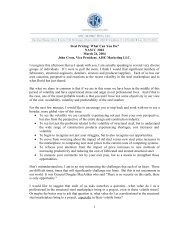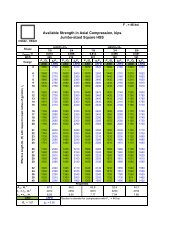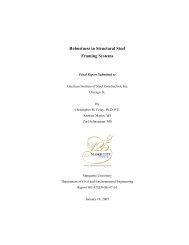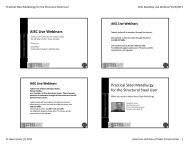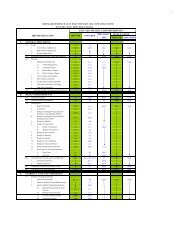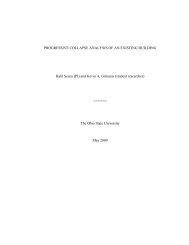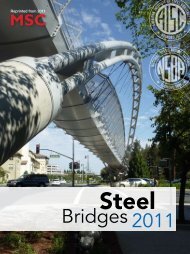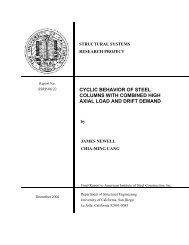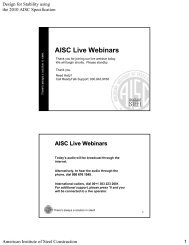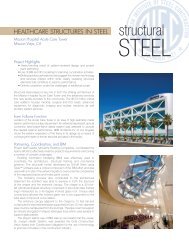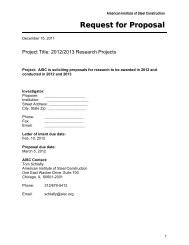High Strength Bolts Handouts 2 per - AISC
High Strength Bolts Handouts 2 per - AISC
High Strength Bolts Handouts 2 per - AISC
- No tags were found...
You also want an ePaper? Increase the reach of your titles
YUMPU automatically turns print PDFs into web optimized ePapers that Google loves.
American Institute of Steel Construction<strong>High</strong> <strong>Strength</strong> <strong>Bolts</strong> - Geoff KulakApril 14, 2011<strong>AISC</strong> Live WebinarsThank you for joining our live webinar today.We will begin shortly. Please standby.Thank you.Need Help?Call ReadyTalk Support: 800.843.9166There’s always a solution in steel.<strong>AISC</strong> Live WebinarsToday’s audio will be broadcast through the internet.Alternatively, to hear the audio through the phone, dial800.952.4629.International callers, dial 00+1+212.231.2934.For additional support, please press *0 and you will beconnected to a live o<strong>per</strong>ator.There’s always a solution in steel.There's always a solution in steel. 1
American Institute of Steel Construction<strong>High</strong> <strong>Strength</strong> <strong>Bolts</strong> - Geoff KulakApril 14, 2011<strong>AISC</strong> Live WebinarsToday’s live webinar will begin shortly.Please standby.As a reminder, all lines have been muted. Please type anyquestions or comments through the Chat feature on the leftportion of your screen.Today’s audio will be broadcast through the internet.Alternatively, to hear the audio through the phone, dial800.952.4629.International callers, dial 00+1+212.231.2934.For additional support, please press *0 and you will beconnected to a live o<strong>per</strong>ator.There’s always a solution in steel.<strong>High</strong>-<strong>Strength</strong> <strong>Bolts</strong>: The BasicsPresented byGeoff Kulak, Ph.D.Professor Emeritus at the University of AlbertaThere’s always a solution in steel.There's always a solution in steel. 2
American Institute of Steel Construction<strong>High</strong> <strong>Strength</strong> <strong>Bolts</strong> - Geoff KulakApril 14, 2011<strong>High</strong>-<strong>Strength</strong> <strong>Bolts</strong>: The Basics• Fundamentals and Behavior• Specification Requirements (<strong>AISC</strong> 2010)5Role of the StructuralEngineer…• Selection of suitable bolttypes and grades• Design of the fasteners• Responsibility for installation• Responsibility for inspection6There's always a solution in steel. 3
American Institute of Steel Construction<strong>High</strong> <strong>Strength</strong> <strong>Bolts</strong> - Geoff KulakApril 14, 2011ASTM A307 <strong>Bolts</strong>• often a good choice when loads arestatic• strength level inferior to high-strength bolts (60(ksi tensile ult.)• pretension indeterminate7ASTM A325 <strong>Bolts</strong>• Type 1 or Type 3 (weathering steel)• ASTM Spec.RCSC Spec.• Minimum tensile strength: 120 ksi• Pretension can be induced if desired8There's always a solution in steel. 4
American Institute of Steel Construction<strong>High</strong> <strong>Strength</strong> <strong>Bolts</strong> - Geoff KulakApril 14, 2011PP{and associatedshear stressτ=PAFree bodyof boltP{ a bearing forceP19Finally...dP/2PtP/2this force is equal andopposite to the bearing forceshown previously20There's always a solution in steel. 10
American Institute of Steel Construction<strong>High</strong> <strong>Strength</strong> <strong>Bolts</strong> - Geoff KulakApril 14, 2011In the example, we identified…• force in the bolt (a shear force)• force that the bolt imposed on the plate (abearing force)• force in the plate itself (a tensile force)• force transfer could also be by friction:not included in this illustration21<strong>AISC</strong> Standard 2010• Parallel LRFD and ASD rules• LRFD uses a resistance factor, Ø• ASD uses a safety factor, Ω• Loads as appropriate:– factored loads for LRFD– non-factored loads for ASD22There's always a solution in steel. 11
American Institute of Steel Construction<strong>High</strong> <strong>Strength</strong> <strong>Bolts</strong> - Geoff KulakApril 14, 2011<strong>AISC</strong> Specification cont’dLRFD:req’d strength LRFD ≤ φ R nASD: req’d strength ASD ≤ R n / Ω23Installation —• Snug-tight only• Pretensioned– Calibrated wrench– Turn-ofof-nut– Other means: Tension control bolts Load-indicator washers24There's always a solution in steel. 12
American Institute of Steel Construction<strong>High</strong> <strong>Strength</strong> <strong>Bolts</strong> - Geoff KulakApril 14, 2011Behavior of a large joint (shear splice) —averageboltshearMPadeformation over α , mm25<strong>Bolts</strong> in Shear: Issues• Shear strength of bolt (single shearor double shear, threads in shearplane?)• Bearing capacity of bolt (nevergoverns)• Bearing capacity of plate• Tensile (comp.) capacity of plate26There's always a solution in steel. 13
American Institute of Steel Construction<strong>High</strong> <strong>Strength</strong> <strong>Bolts</strong> - Geoff KulakApril 14, 2011Slip in bolted joints…• Can be as much as two holeclearances• Some bolts will already be in bearingat start of loading• Both laboratory tests and fieldmeasurements indicate that slip ismore like 1/2 hole clearance27<strong>Bolts</strong> in shear-type connections:Specifications include information for:– bearing type connections– slip-critical connections28There's always a solution in steel. 14
American Institute of Steel Construction<strong>High</strong> <strong>Strength</strong> <strong>Bolts</strong> - Geoff KulakApril 14, 2011Bearing-type connections:• Issues– bolt shear strength– bearing capacity of connected material– member strength• Shear strength of bolts is not dependenton presence or absence of pretension.(How come?)29<strong>Bolts</strong> in bearing-type connections…loadRegion of bearing-type behaviordeformation30There's always a solution in steel. 15
American Institute of Steel Construction<strong>High</strong> <strong>Strength</strong> <strong>Bolts</strong> - Geoff KulakApril 14, 2011Bolt Shear <strong>Strength</strong>• Bolt shear strength ≈ 62% of bolt ultimatetensile strength (theory(+ tests)– Design rule takes 90% of this value– Threads in shear plane?– Long joint effect: another discountapplied.31Individual bolt in shear32There's always a solution in steel. 16
American Institute of Steel Construction<strong>High</strong> <strong>Strength</strong> <strong>Bolts</strong> - Geoff KulakApril 14, 2011Physical test —33Uneven loadingof bolts –(End four bolts of 13)34There's always a solution in steel. 17
American Institute of Steel Construction<strong>High</strong> <strong>Strength</strong> <strong>Bolts</strong> - Geoff KulakApril 14, 2011Bolt Pretension v. Shear• The bolt pretension is attained as a result of smallaxial elongations introduced as nut is turned on• These small elongations are relieved as sheardeformations and shear yielding take place• Confirmed by both bolt tension measurementsand shear strength tests• So, bolt shear strength NOT dependent onpretension in the bolt.35Back to bolt in shear —Shear strengthof single bolt(tests) —τ = 0.62 σ u boltShear deformation36There's always a solution in steel. 18
American Institute of Steel Construction<strong>High</strong> <strong>Strength</strong> <strong>Bolts</strong> - Geoff KulakApril 14, 2011<strong>Bolts</strong> in Shear — <strong>AISC</strong>φ R = φnFnvAbφ R n= design shearstrengthF nv = nominal shear strength, ksi37nominal shear strength …F = 90% (0.625×F ) =nvu0.563Fue.g. A325 bolt,no threadsin shear plane,GroupA :see tabulatedvaluein Table J3.2(0.563ksi Fu = 0.563 x 120 ksi = 68 ksi)38There's always a solution in steel. 19
American Institute of Steel Construction<strong>High</strong> <strong>Strength</strong> <strong>Bolts</strong> - Geoff KulakApril 14, 2011and…For threads included, , the tabulatedvalues are 80% of the above.39Comments…• The discount for length (use of 90%) isconservative• If joint length > 38 in., a further reduction,to 83%• The ø – value used for this case (0.75) isconservative40There's always a solution in steel. 20
American Institute of Steel Construction<strong>High</strong> <strong>Strength</strong> <strong>Bolts</strong> - Geoff KulakApril 14, 2011Let’s s return now to slip-criticalconnections…Slip-Critical ConnectionClamping force from bolts (bolt pretension)Load at which slip takes placewill be a function of …?42There's always a solution in steel. 21
American Institute of Steel Construction<strong>High</strong> <strong>Strength</strong> <strong>Bolts</strong> - Geoff KulakApril 14, 2011<strong>Bolts</strong> in slip-critical connections…loaddeformationregion of slip-criticaljoint behavior43Slip-critical joints specified when…• Load is repetitive and changesfrom tension to compression(fatigue by fretting couldoccur.)• Change in geometry ofstructure would affect its<strong>per</strong>formance.• Certain other cases.• Comment: : for buildings, slip-critical joints should be theexception, not the rule (but,see also seismic rules)44There's always a solution in steel. 22
American Institute of Steel Construction<strong>High</strong> <strong>Strength</strong> <strong>Bolts</strong> - Geoff KulakApril 14, 2011First principles, slip resistance is —P=knΣs T ik s = slip coefficient (µ)n = number of slip planes (usually 1 or 2)T i = clamping force (i.e., bolt pretension)45Design slip resistance, <strong>AISC</strong>Rn= μ DuhfTbnsslip coefficientno. slip planesclamping force…terms h f and D u need to be definedand a value inserted for Ø46There's always a solution in steel. 23
American Institute of Steel Construction<strong>High</strong> <strong>Strength</strong> <strong>Bolts</strong> - Geoff KulakApril 14, 2011<strong>Bolts</strong> in Tension• Capacity of a bolt in tension: product ofthe ultimate tensile strength of the boltand the tensile stress area of the bolt(i.e. F u A st )• Specifications directly reflect thiscalculated capacity (…to(come)• Force in bolt must reflect any pryingaction effect49<strong>Bolts</strong> in Tension – some comments• Preference: avoid joints that put boltsinto tension, especially if fatigue is anissue• Use A325 bolts rather than A490 bolts• Minimize the prying action50There's always a solution in steel. 25
American Institute of Steel Construction<strong>High</strong> <strong>Strength</strong> <strong>Bolts</strong> - Geoff KulakApril 14, 2011And the result is…• The bolt force does increase, but notby very much (≅ 7%)• This increase is accommodatedwithin the design rule.53<strong>AISC</strong> rule, bolts in tension—φRn=φFntAbbolt area for nominaldiameternominal tensile strengthφ R n = designtensile strength54There's always a solution in steel. 27
American Institute of Steel Construction<strong>High</strong> <strong>Strength</strong> <strong>Bolts</strong> - Geoff KulakApril 14, 2011What is nominal tensile strength, F nt ?Pult = FuAst=Fu(0.75Ab)or , P =ult0.75 FuAbAdjusted area{Call this F nt55So, the <strong>AISC</strong> rule for bolts in tension…φ R = φ Fnn tAbwhere F nt = 0.75 F u as tabulatedin the SpecificationAs we now know, the 0.75 reallyhas nothing to do with F u56There's always a solution in steel. 28
American Institute of Steel Construction<strong>High</strong> <strong>Strength</strong> <strong>Bolts</strong> - Geoff KulakApril 14, 2011Returning to shear splice joints,we still have to deal with thebearing capacity of the connectedmaterial.dP/2PP/2t57Bearing capacity (ofconnected material)Shear-out of ablock of materialor yielding58There's always a solution in steel. 29
American Institute of Steel Construction<strong>High</strong> <strong>Strength</strong> <strong>Bolts</strong> - Geoff KulakApril 14, 2011Bearing stresses at bolt holes…sL et 1L ct 2Needed:1. shear-out rule2. yield rule(deformation)d59Shear-out rule…Shearor,R- out isn2 ( τult= 2 ( 0.75 σu× L× Lcc× t)× t)and <strong>AISC</strong> rule is: R n = 1.5 F u L c t60There's always a solution in steel. 30
American Institute of Steel Construction<strong>High</strong> <strong>Strength</strong> <strong>Bolts</strong> - Geoff KulakApril 14, 2011Plate bearing…from tests:σσb=pluL ed..after some arithmetic Rn= σ d t = σbpluLde dtvalid for Le ≥3 d61Plate bearing…Making the substitution and usingFu≡ σpluR n = 3 d t F u62There's always a solution in steel. 31
American Institute of Steel Construction<strong>High</strong> <strong>Strength</strong> <strong>Bolts</strong> - Geoff KulakApril 14, 2011Finally, the <strong>AISC</strong> rule forplate bearing capacity is …Rn= 1.5 FuLct≤3.0 dtFu(with a φ-value still to be inserted)63Further note re bearing…When deformation a consideration,useRn= 1.2 FuLct≤2.4 dtFuWhy this difference, and when do weuse the latter? (value of φ still to beapplied)64There's always a solution in steel. 32
American Institute of Steel Construction<strong>High</strong> <strong>Strength</strong> <strong>Bolts</strong> - Geoff KulakApril 14, 2011Block shearrupture65Failure (ult. load) isby tensile fracture atlocation shown,regardless ofgeometricproportions.Shear yield along verticalplanes.Failure is controlled byductility – not strength.66There's always a solution in steel. 33
American Institute of Steel Construction<strong>High</strong> <strong>Strength</strong> <strong>Bolts</strong> - Geoff KulakApril 14, 2011Basics…Tr+ Vwhereandr= φ AAAntgvntFu+0.60 φ Agv= net area in tension= gross area in shearFytension fractureshear yield…and some other requirements, includingspecific case of coped beams, limit on shear67An example ofshear + tensionfailure in acoped beam…68There's always a solution in steel. 34
American Institute of Steel Construction<strong>High</strong> <strong>Strength</strong> <strong>Bolts</strong> - Geoff KulakApril 14, 2011Back to installation…69Bearing-Type Connections—Installation of <strong>Bolts</strong>• <strong>Bolts</strong> can be installed to “snug-tightcondition — ordinary effort of worker usinga spud wrench. (Pretension unknown, butusually small)70There's always a solution in steel. 35
American Institute of Steel Construction<strong>High</strong> <strong>Strength</strong> <strong>Bolts</strong> - Geoff KulakApril 14, 2011Installation —– bring parts together, continue turning nut,bolt elongates, tension develops in bolt, andclamped parts compress711. Calibrated WrenchInstallation• Reliable relationship between torqueand resultant bolt tension?NO ! (and forbidden by RCSC)• Establish relationship by calibrationof the installing wrench.72There's always a solution in steel. 36
American Institute of Steel Construction<strong>High</strong> <strong>Strength</strong> <strong>Bolts</strong> - Geoff KulakApril 14, 2011Hydraulic calibrator –73Calibrated wrench, cont’d• Adjust wrench to stall or cut out atdesired level of bolt pretension• Target value of pretension (RCSC) is1.05 times specified min. value• Calibrate using at least three bolts• Calibration is unique to bolt lot,length, diameter, grade of bolt• Washers must be used74There's always a solution in steel. 37
American Institute of Steel Construction<strong>High</strong> <strong>Strength</strong> <strong>Bolts</strong> - Geoff KulakApril 14, 20112. Turn-ofof-Nut Installation• Run nut down, bring parts into closecontact• Work from stiffer regions to edges• Establish “snug-tight” condition (firstimpact of impact wrench or full effort ofworker using a spud wrench)• Apply additional one-half turn (or othervalue, depending on bolt length)75Does thisdefinition ofsnug-tightseem a littlevague?How influential is “snug-tight?”76There's always a solution in steel. 38
American Institute of Steel Construction<strong>High</strong> <strong>Strength</strong> <strong>Bolts</strong> - Geoff KulakApril 14, 201160Bolt Tension by Turning the Nutbolttension(kips)40specified minimumtension20range of boltelongationsat snug0.02 0.040.060.08bolt elongation (in.)bolt elongation at one-half turn7760Bolt Tension by Turning the Nutbolttension(kips)40specified minimumtension200.02 0.04bolt elongation (in.)bolt elongation at one-half turn78There's always a solution in steel. 39
American Institute of Steel Construction<strong>High</strong> <strong>Strength</strong> <strong>Bolts</strong> - Geoff KulakApril 14, 2011Inspection of Installation• Principles:– Determination of the bolt pretensionafter installation is not practical– Understand the requirements e.g., arepretensioned bolts required?– Monitor the installation on the site– Pro<strong>per</strong> storage of bolts is required79Inspection of Installation• Is bolt tension required? — if not, whyinspect for it !• Know what calibration process is requiredand monitor it on the job site• Observe the work in progress on a regularbasis80There's always a solution in steel. 40
American Institute of Steel Construction<strong>High</strong> <strong>Strength</strong> <strong>Bolts</strong> - Geoff KulakApril 14, 2011Inspection of installation:Consider the following <strong>AISC</strong> cases —1. <strong>Bolts</strong> need be snug-tight only2. <strong>Bolts</strong> are pretensioned (but not a slip-critical joint)3. Slip-critical joint81Snug tight only req’d….• Bearing-type connections• <strong>Bolts</strong> in tension (A325 only)– only when no fatigue or vibration (boltcould loosen)82There's always a solution in steel. 41
American Institute of Steel Construction<strong>High</strong> <strong>Strength</strong> <strong>Bolts</strong> - Geoff KulakApril 14, 2011Inspection – snug tight• <strong>Bolts</strong>, nuts, and washers (if any) must meetthe requirements of the specifications• Hole types (e.g., slotted, oversize) mustmeet specified requirements• Contact surfaces are reasonably clean• Parts are in close contact after boltssnugged• All material within bolt grip must be steel83Inspection: if pretensioned bolts required…• All of requirements for snug-tight case• Observe the pre-installation verification process– turn of nut, or;– calibrated wrench, or;– other (direct tension washers, tension-controlbolts)• Calibration process done minimum once <strong>per</strong> day• Calibration process done any time conditionschange84There's always a solution in steel. 42
American Institute of Steel Construction<strong>High</strong> <strong>Strength</strong> <strong>Bolts</strong> - Geoff KulakApril 14, 2011Inspection: for slip-criticaljoints• All of the above, plus• Condition of faying surfaces, holes, etc.• In addition to observing the calibrationprocess, the inspection must ensure thatthe same process is applied to the fieldjoints85An inspected joint (turn-ofof-nut)86There's always a solution in steel. 43
American Institute of Steel Construction<strong>High</strong> <strong>Strength</strong> <strong>Bolts</strong> - Geoff KulakApril 14, 2011and some other comments…• Pretension values greater thanthose specified are not causefor rejection.• Rotation tests are useful forshort-grip bolts or coatedfasteners (requirement is inASTM A325 spec. and is forgalvanized bolts)8788There's always a solution in steel. 44
American Institute of Steel Construction<strong>High</strong> <strong>Strength</strong> <strong>Bolts</strong> - Geoff KulakApril 14, 2011Actual pretensions, cont’d• For A325 bolts, turn-of-nut:– Average tensile strength exceeds spec.min. tensile by about 1.18– Average pretension force is 80% ofactual tensile– Result is that actual bolt tension isabout 35% greater than specified bolttension89Actual pretensions, cont’d• A325, ½ turn-of-nut: 35% increase• A490, ½ turn-of-nut: 26% increase• A325 and A490, calibrated wrench: 13%increase• etc. for other casesNote: these increased pretensions areembodied in the specification rules90There's always a solution in steel. 45
American Institute of Steel Construction<strong>High</strong> <strong>Strength</strong> <strong>Bolts</strong> - Geoff KulakApril 14, 2011Some other options for bolts —91Tension Control <strong>Bolts</strong>region ofconstant torqueASTM F1852,F2280groove at which shearwill take place92There's always a solution in steel. 46
American Institute of Steel Construction<strong>High</strong> <strong>Strength</strong> <strong>Bolts</strong> - Geoff KulakApril 14, 2011Tension control bolts….• NOTE: evidence that tips havesheared off is not in itself evidencethat desired pretension is present• Consider limits:– Friction conditions are very high…– Friction conditions are very low…• Hence, calibration is essential!93Tension-Control <strong>Bolts</strong>• Advantages– Installation is from one side– Electric wrench is used– Installation is quiet• Disadvantages– More expensive– Pre-installation calibration required94There's always a solution in steel. 47
American Institute of Steel Construction<strong>High</strong> <strong>Strength</strong> <strong>Bolts</strong> - Geoff KulakApril 14, 2011Direct tension indicators—95Direct Tension Indicators• Protrusions formed inspecial washer• Protrusions compressas force in bolt isdeveloped• Use feeler gage tomeasure gap (or refusal)• User must verify the process(like calibrated wrench)ASTM 95996There's always a solution in steel. 48
American Institute of Steel Construction<strong>High</strong> <strong>Strength</strong> <strong>Bolts</strong> - Geoff KulakApril 14, 2011Reliability of these...• Calibration required• Reliability same as calibrated wrench• Tension-control bolt is torque-dependent• Load-indicating washer is elongation-dependent97Some additional topics …• Details, other topics– washers (but not today!)– slotted or oversize holes (but not today!)– seismic design98There's always a solution in steel. 49
American Institute of Steel Construction<strong>High</strong> <strong>Strength</strong> <strong>Bolts</strong> - Geoff KulakApril 14, 2011Seismic design of connections• Analyze structure in order tocompute the forces– Use FEMA 350 and/or <strong>AISC</strong> SeismicDesign Spec.• With forces now known, designconnectors• Advisable to use pre-qualifiedconfigurations99Pre-qualified bolted connectionsNote: some details not shown,e.g., continuity plates100There's always a solution in steel. 50
American Institute of Steel Construction<strong>High</strong> <strong>Strength</strong> <strong>Bolts</strong> - Geoff KulakApril 14, 2011All-bolted connection101…bolted joints, seismic design• All bolts pretensioned• Faying surfaces as <strong>per</strong> slip-critical• Use bearing values for bolts– moderate quakes: no slip– major quakes: slip will occur and bolts go into bearing• Normal holes or short slotted only (<strong>per</strong>pendicular)• No bolts + welds in same faying surface102There's always a solution in steel. 51
American Institute of Steel Construction<strong>High</strong> <strong>Strength</strong> <strong>Bolts</strong> - Geoff KulakApril 14, 2011Seismic design, cont’d• Non-ductile limit state in either member orconnection must not govern.• Calculate bolt shear strength as <strong>per</strong>bearing type but use 2.4 d t F u bearing rule• Must use expected yield and ultimatestrengths, not the specified valuese.g.A36 plate :use1.3 σyspec.103It all started with rivets….104There's always a solution in steel. 52
American Institute of Steel Construction<strong>High</strong> <strong>Strength</strong> <strong>Bolts</strong> - Geoff KulakApril 14, 2011Designexample:gusset plateconnection105Determine ultimate load for this gussetplate (which is one that was tested)14.76F y = 39.9 ksiF u = 69.0 ksi7/8 A325 bolts15.75(holes 15/16 in.)P utest =164 kips(compression)23@2.76=8.272.68t = 0.26 in.19.697.2230°106There's always a solution in steel. 53
American Institute of Steel Construction<strong>High</strong> <strong>Strength</strong> <strong>Bolts</strong> - Geoff KulakApril 14, 2011Set out the issues…• Brace force in tension–– slip load of bolts (no slip at service load)– shear load of bolts– bearing capacity of plate– block shear107Continuing…• Brace force in compression– slip capacity of bolts (already checked for loadin tension)– shear capacity of bolts (already checked forload in tension)– bearing capacity of plate (already checked)– block shear (doesn’t t apply)– capacity of gusset plate in compression (New)108There's always a solution in steel. 54
American Institute of Steel Construction<strong>High</strong> <strong>Strength</strong> <strong>Bolts</strong> - Geoff KulakApril 14, 2011Slip load (calculate at factored load level)Rn =μDuhfTbns(<strong>per</strong>bolt)μ = 0.30 (clean mill scale)AFunbs= π d2/ 4 = 0.60 in.= 120 ksi (A325 bolts)= 2 slip planes2h= 1.0(7/8 in.dia.)f(no fills))Tb=spec. min. bolt pretension= 0.75×0.60 in.2= (0.75×A)(F× 120 ksi×70% = 37.88 kipsbu)70%109Slip load calculation cont’d.Rn= μ DuhfTbNs(<strong>per</strong>bolt)= 0.30×1.13 × 1.0×37.88 kip×2 slip planes=25.68 kips / bolt(std.holes) :or,for 8 bolts, ( = 1.0); R = n205 kipsφ 110There's always a solution in steel. 55
American Institute of Steel Construction<strong>High</strong> <strong>Strength</strong> <strong>Bolts</strong> - Geoff KulakApril 14, 2011Shear resistance of boltsφRn=φFvAbUse ø =1.0 so that we can compare thisload with the test load, assume threads inshear plane, no joint length effectF v = 90% [0.62×120 ksi] = 68 ksiφ Rn= 1.0×68 ksi × 0.60 in.or, for 8 bolts,2 shear planes, threads in shear plane= (41.0×8×2)kips × 0.80 = 525 kips2= 41.0 kips (<strong>per</strong> bolt)111Bearing resistance (use φ = 1.0)Rn= 1.5 FuLct≤3.0 dtFu3 d t Fu=3×7 /8 in. × 0.26 in. × 69.0 ksi=47.1 k/bolt1.5 Lct Fu=1.5×1.53 in. × 0.26 in. × 69.0 ksi=41.2 k112There's always a solution in steel. 56
American Institute of Steel Construction<strong>High</strong> <strong>Strength</strong> <strong>Bolts</strong> - Geoff KulakApril 14, 2011Bearing resistance……the governing value is 41.2 kips/boltand, for 8 bolts—Bearing resistance is 330 kips113Block shear3@2.76=8.272.002.682nt = (0.26)(2.68 −15/16)0.45 in.A =2gv = (8.27 + 2.00)2 × 0.26 5.34 in.A =Tr+ Vr= φ AntFu+ 0.60 φ AgvFy114There's always a solution in steel. 57
American Institute of Steel Construction<strong>High</strong> <strong>Strength</strong> <strong>Bolts</strong> - Geoff KulakApril 14, 2011Block shear, cont’d2Tr = 0.45 in. × 69.0 ksi = 31.0 kips2Vr = 0.60 × 5.34 in. × 39.9 ksi = 127.8 kipsand the total block shear resistance(unfactored) is (31 +128) =159 kips115Brace force in compression:issue is swaybuckling inthis region116There's always a solution in steel. 58
American Institute of Steel Construction<strong>High</strong> <strong>Strength</strong> <strong>Bolts</strong> - Geoff KulakApril 14, 2011Checking the buckling…• Whitmore method (checks yield)• Thornton method (checks buckling)• Modified Thornton method (checksbuckling)117Whitmoremethod….• Use beam formulae tocheck <strong>per</strong>ceivedcritical sections• Use 30 o , as shown tocheck yielding atlocation shown.• Does not predictultimate capacity verywell, usuallyconservative butsometimes non-conservative30°118There's always a solution in steel. 59
American Institute of Steel Construction<strong>High</strong> <strong>Strength</strong> <strong>Bolts</strong> - Geoff KulakApril 14, 2011Thornton method…• Use longest (oraverage) of L 1 , L 2 , L 3to compute abuckling load on aunit width column,then apply this to thetotal width.• Use k = 0.65 in thecolumn formulae30°L 1L 2L 3119Thornton method, modifiedAs <strong>per</strong> Thorntonmethod butspread load outat 45 oL 3L 1L 245 o 120There's always a solution in steel. 60
American Institute of Steel Construction<strong>High</strong> <strong>Strength</strong> <strong>Bolts</strong> - Geoff KulakApril 14, 2011Yam & Cheng gusset plate tests(U of A, 13 tests)PPuWPPuTPPuT'mean 1.33 1.67 1.06std. dev. 0.26 0.12 0.08we’ll use this method121Calculations for buckling capacity:L 1L 2Using scale dwg.L 2 = 9.65 in.Width of the 45 obase is 19.2 in.L 3φ PFccrn= φ A F (useφ= 1.0)c= (0.658gcrF / Fy e) F use k = 0.65yc122There's always a solution in steel. 61
American Institute of Steel Construction<strong>High</strong> <strong>Strength</strong> <strong>Bolts</strong> - Geoff KulakApril 14, 2011Consider a 1 in. widestrip that is 9.65 in. longlength =9.65width = 1t = 0.26r =IA=112× 1×0.260.26 × 13= 0.0751 in.and then completing the calculations,P n = 6.91 kips (on a 1 in. wide strip)123And applying this to the total width…P u = (6.91 k/in.) (19.2 in.) = 132 kipsand the test ultimate load on this particularspecimen was 164 kipsso, P u / P T’ = 1.23(The corresponding ratios for Whitmoreand Thornton for this specimen were 1.31and 1.80)124There's always a solution in steel. 62
American Institute of Steel Construction<strong>High</strong> <strong>Strength</strong> <strong>Bolts</strong> - Geoff KulakApril 14, 2011Summary of our calculationsBraceForcesliploadboltshearplatebearingblockshearbucklingtestloadTension 205 525 330 159 — —Compress. — — — — 132 164125Some references —Load and Resistance Factor DesignSpecification for Structural JointsUsing ASTM A325 or A490 <strong>Bolts</strong>,Research Council on StructuralConnections, 2004 (RCSC)(free download available atboltcouncil.org)126There's always a solution in steel. 63
American Institute of Steel Construction<strong>High</strong> <strong>Strength</strong> <strong>Bolts</strong> - Geoff KulakApril 14, 2011References, cont’d.• G.L. Kulak, J.W. Fisher, and J.A.H. Struik, Guide to DesignCriteria for Bolted and Riveted Joints, , Second Edition, JohnWiley, New York, 1987 (free download at RCSC website)• Bickford, John H., "An Introduction to the Design andBehavior of Bolted Joints," Second Edition, Marcel DekkerInc., New York, 1990• G.L. Kulak, A Bolting Primer for Structural Engineers, , <strong>AISC</strong>Design Guide 17, Chicago, 2002• Larry Kloiber and Larry Muir, “The 2010 <strong>AISC</strong> Specification:Changes in Design of Connections,” Modern SteelConstruction, Sept. 2010127Thank You!Please give us your feedback!www.aisc.org/cesurvey128There's always a solution in steel. 64
American Institute of Steel Construction<strong>High</strong> <strong>Strength</strong> <strong>Bolts</strong> - Geoff KulakApril 14, 2011<strong>AISC</strong> Seminars2011 Spring Schedule – 6 seminar topics coming to26 citiesUpcoming Cities for April:Detroit – Houston – DenverUpcoming Cities for May:St. Louis – Boston - MiamiPhiladelphia – Sacramentowww.aisc.org/seminars<strong>AISC</strong> Seminars2 nd Thursday of the month• No webinar in May• June 9, 2011: Extended Shear Plate Connections –Larry Muir• July 14, 2011: Design For Stability – LouGeschwindnerwww.aisc.org/webinarsThere's always a solution in steel. 65
American Institute of Steel Construction<strong>High</strong> <strong>Strength</strong> <strong>Bolts</strong> - Geoff KulakApril 14, 2011<strong>AISC</strong> eLearningOver 60 hours of presentations availableanytime, online.CEUs/PDHs are available.www.aisc.org/elearning<strong>AISC</strong> SteelCamp2 day, 4 topics, 15 hours of ContinuingEducation,One low price.New York City – June 16-17San Francisco – July 21-22www.aisc.org/steelcampThere's always a solution in steel. 66



